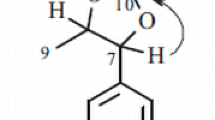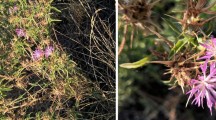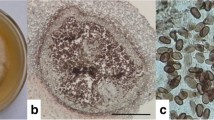Metabolites from Phoma sp., a phytopathogenic fungus, were exploited for their herbicidal potential. The phytotoxic compound isolated was identified as anhydropseudophlegmacin-9,10-quinone-3′-amino-8′-O-methyl ether on the basis of spectral data. The isolated pigment was tested for its herbicidal potential against the prominent weeds of Central India, where a positive result was obtained.
Similar content being viewed by others
Avoid common mistakes on your manuscript.
Weeds are important pests, which cause economic losses in agricultural and forestry systems and serious ecological problems, and which are capable of altering the ecosystem, displacing native flora and fauna [1]. Plant pathogenic microbes have been a novel and lucrative source of a wide range of bioactive compounds with herbicidal potential. Phoma is a well-known phytopathogen responsible for many diseases in plants and is known to produce an array of bioactive extracellular phytotoxic compounds [2,3]. Anthraquinones have also been isolated from Phoma foveata [4], while other fungi too have been reported to exhibit biological activity [5]. As part of our search for potential herbicidal agents, presently we describe the isolation, purification, and characterization of a pigment exhibiting herbicidal potential against, the prominent weeds of Central India. This is the first report where a pigment, i.e., anhydropseudophlegmacin-quinone, exhibits herbicidal potential against the target weeds.
The red pigment, R f 0.30, was obtained as an optically active light yellow powder, mp 232°C, \( \left[ \alpha \right]_{\text{D}}^{25} \) + 33.14° (c 0.91; MeOH), in a yield of 2 × 10–2% of fresh weight of the fungus. The electron spray ionization mass spectrum (ESI-MS) displayed a molecular ion peak at m/z 523 corresponding to the molecular formula C30H21O8N. This formula suggests the presence of a dimeric octaketide structure, whereas the long-wavelength absorption at 500 nm in the electronic spectrum suggested the presence of an anthraquinone chromophore. The IR absorption bands at 3482, 3208, and 1610 cm–1 indicated the presence of hydroxyl, amino, and quinone carbonyl groups in the compound. The 1H NMR spectrum of the pigment revealed the presence of seven aromatic protons, four of which showed a doublet at δ 6.91, 6.85, 6.66, and 6.94 ppm, whereas the remaining three showed a sharp aromatic proton singlet at δ 7.26, 7.10, and 7.25 ppm. Comparison of these data with those reported in the literature revealed that the new anthraquinone corresponds to a combination of subunits – A (torosachrysone-8-O-methyl- ether) and B (emodin-1-O-methyl ether) joined at the C-10′ and C-5 position, respectively [6–8].

The structure of the compound was further confirmed by the 13 C NMR data, which show a total of 30 carbon resonances. Table 1 shows the 1H and 13 C NMR chemical shift values. Among other things, the presence of ketone and quinone carbonyl groups was confirmed by peaks at δ 210.9, 189.3, and 191.2 ppm. The 13 C NMR spectrum also reveals the presence of four hydroxy groups at C-1, C-6, C-8, and C-9′ (δ 163.5, 162.9, 166.1, and 162.6 ppm), a methyl group (δ 22.6), and a methoxyl group (δ 43.5). An amino group attached to C-3′ was confirmed by the peak at 8 154.8 ppm. All of the data discussed so far support the anhydropseudophlegmacin-quinone structure for the new red pigment. Thus, on the basis of the above data, the structure of this new pigment was assigned as anhydropseudophlegmacin-9,10-quinone-3′-amino-8′-O-methyl ether (1).
Experimental
Melting points were measured on a MAC model melting point apparatus and are uncorrected. Optical rotations were measured on a Rudolf Autopol III polarimeter. UV spectra were measured on a Thermospectronic UV 100 model spectrophotometer in MeOH solution.1H NMR and 13 C NMR were recorded on a Bruker DRX 300 model spectrometer operating at 300 MHz and 75 MHz (CD3OD or CDCl3). All the NMR spectra were recorded using TMS as an internal standard.
IR spectra were recorded on a Shimadzu 8400S spectrophotometer having a range of 4000–450 cm–1. The ESI-MS was recorded on a Micromass Quattro II triple quadrupole mass spectrometer. Column chromatography was carried out on silica gel (Merk B.D.H.; 60–120 mesh), and TLC and preparative TLC on 20 × 20 cm plates coated with 2 mm thick silica gel (Merck; F254). Spots were visualized by keeping plates in an iodine chamber.
Fungus Material. The fungal strain Phoma herbarum FGCC#54 was obtained from the Fungal Germplasm Collection Center (FGCC), Mycological Research Laboratory, Department of Biological Sciences, Rani Durgavati University, Jabalpur, Madhya Pradesh, India. The fungus was maintained on potato dextrose medium at 4 ± 1°C for further studies. The fungal pathogen was isolated earlier from the phylloplane of the weed Parthenium.
Extraction of CFCF. Under aseptic conditions, the metabolized growth medium was filtered through pre-weighed Whatman filter paper No. 1 and was centrifuged at 4000 × g for 10 min. The pellet was discarded, and the supernatant was again passed through a Sartorius 0.45 μm filter (Sartorius, Gottingen, Germany) under in vacuo conditions to obtain the final CFCF [9].
Purification of Phytotoxic Compound. CFCF (20 g) was dissolved in water and subjected to solid-phase extraction. The column was eluted with MeOH. The eluent thus obtained was checked for phytotoxicity, and further purification was done by preparative TLC on silica gel plates using the solvent system n-hexane–EtOAc–acetic acid (88:10:2). The compound thus obtained was pre-concentrated using solid-phase extraction (SPE). This is often the best way to extract and pre-concentrate organics at low or very low levels from aqueous systems.
Phytotoxicity Testing by Detached Leaf Bioassay. Leaves detached from the plant were surface sterilized with 2% NaOCl. An area of approximately 3 mm2 on the upper leaf surface was gently scratched and 20 μL of the toxin was injected by using sterilized syringe, which was diluted to 250 μL/mL on each half leaf. The leaves were then incubated on sterilized moist filter paper in 9 cm Petri plates using cotton and filter paper under continuous fluorescent light at 28 ± 1°C. The effect was observed after 72 h at room temperature [10]. Sterilized, unmetabolized growth medium was taken as control, and the sterilized distilled water was taken as control over control (control b). The experiment was carried out in triplicate. Results are given as mean ± standard error. Phytotoxic damage was recorded on the basis of a phytotoxic scale of 0.00–5.00.
Anhydropseudophlegmacin-9,10-quinone-3′-amino-8′- O -methyl Ether (1). Red powder, mp 232°C. ESI-MS m/z 523 (C30H21O8N). UV (MeOH, λmax, nm): 240. IR (KBr, νmax, cm–1): 3482, 3208, 2361, 1610, 1512, 1389, 1109, 536. For 1H and 13 C NMR (CDCl3) data, see Table 1.
The isolated anthraquinone pigment was tested for its herbicidal potential against four prominent weeds of Madhya Pradesh, India viz., Parthenium hysterophorus, Lantana camara, Hyptis suaveolens, and Sida acuta. Maximum phytotoxic damage occurred on Parthenium, followed by Lantana and Hyptis. Less herbicidal effect was induced on Sida (Table 2).
References
R. J. Turnera, G. Davies, H. Moore, A. C. Grundy, and A. Mead, Crop Protect., 26, 377 (2007).
H. H. Chan, L. Chia-Ying, A. G. Damu, and W. Tian-Shung, Chem. Pharm. Bull., 53, 1232 (2005).
G. A. Strobel , D. Kenfield, G. Bunkers, F. Sugawara, and J. Clardy, Experientia, 47, 819 (1991).
I. R. Bick and C. Rhee, Biochem. J., 98, 112 (1966).
M. S. Buchanan, M. Gill, P. Millar, S. Phonh-Axa, E. Raudies, and J. Yu, J. Chem. Soc. Perkin Trans. 1, 795 (1999).
P. Graupner, A. Carr, E. Clancy, J. Gilbert, K. L. Bailey, J. A. Derby, and B. C. Gerwick, J. Nat. Prod., 66, 1558 (2003).
L. Martinkova, P. J. Zlova, and D. Vesely, J. Appl. Microbiol., 79, 609 (2008).
M. S. C. Pedras, C. C. Erosa-Lopez, J. W. Quail, and J. L. Taylor, Bioorganic. Med. Chem. Lett., 9, 3291 (1999).
H. L. Walker and G. E. Templeton, Plant Sci. Lett., 13, 91 (1978).
P. Sharma, S. R. Sharma, and M. Sindhu, Indian Phytopathol., 57, 315 (2004).
Acknowledgement
This work was financially supported by the Madhya Pradesh Biotechnology Council, Bhopal, India (Grant No. 338/A-5/2007). We are grateful to the Head, Department of Biological Sciences, R. D. University, Jabalpur, M. P. India and CDRI, Lucknow India for providing necessary laboratory and instrumental facilities.
Author information
Authors and Affiliations
Corresponding author
Additional information
Published in Khimiya Prirodnykh Soedinenii, No. 4, pp. 465–467, July–August, 2011.
Rights and permissions
About this article
Cite this article
Quereshi, S., Khan, N.A. & Pandey, A.K. Anthraquinone pigment with herbicidal potential from Phoma herbarum FGCC#54. Chem Nat Compd 47, 521–523 (2011). https://doi.org/10.1007/s10600-011-9986-1
Received:
Published:
Issue Date:
DOI: https://doi.org/10.1007/s10600-011-9986-1




